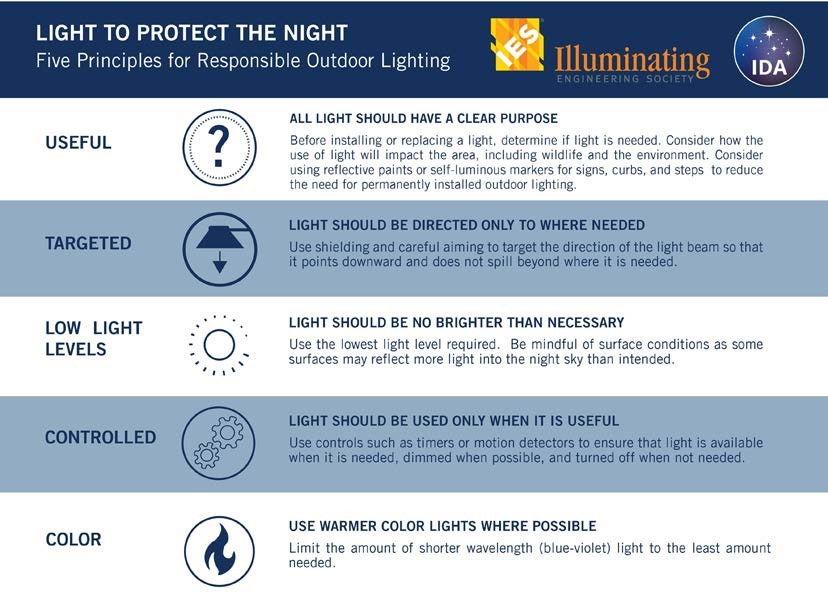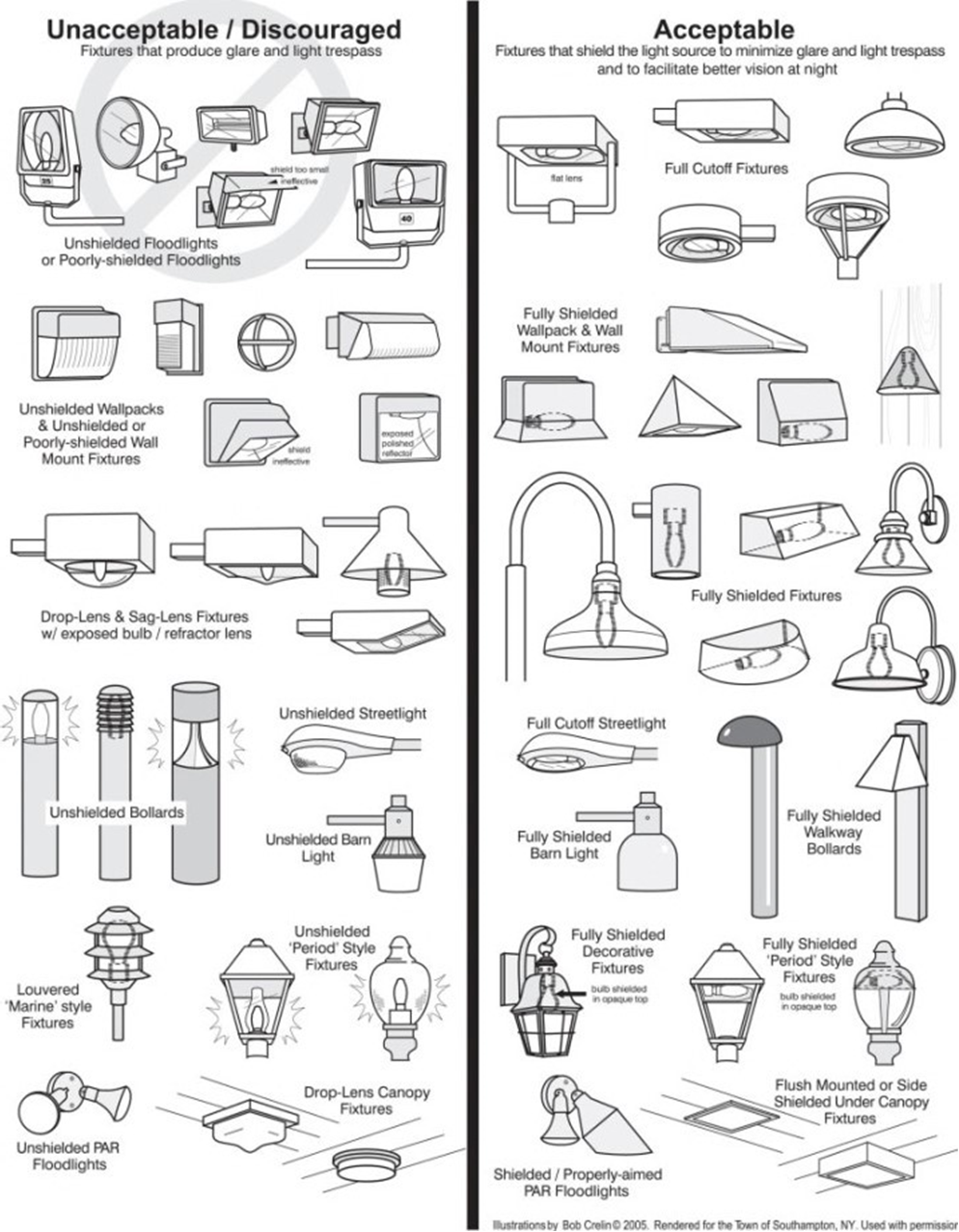- Outdoor lighting fixtures using lamps or bulbs, regardless of the number of bulbs and level of initial lamp lumens, shall not exceed 3,000 kelvins and meet the following:
| Initial Lamp Lumens |
Shielding Requirement |
| ≥ 1,500 |
Fully |
| ≤ 1,499 |
None |
- All new outdoor lighting shall not cause light trespass and shall protect properties from glare and excessive lighting. Outdoor lighting fixtures shall be sufficiently shielded and aimed such that spillage of light onto adjacent properties is minimized and glare from the light emitting and/or reflecting parts of a luminaire is not visible from an adjacent property.
- Sag-lens, drop-lens and mercury vapor fixtures are prohibited.
- The installation of any barn light fixture for use as outdoor lighting is prohibited unless the fixture includes a full opaque reflector instead of the standard translucent lens.
- Outdoor up lighting is prohibited, except in cases where the fixture is shielded by a roof overhang or similar structural shield that will not cause light to extend beyond the structural shield.
- Up lighting and down lighting of flagpoles on private property is permitted:
- Flagpoles illuminated from below are limited to a height of 25 feet above ground level and shall be illuminated with a single spot-type fixture whose maximum initial output is 52 lumens per foot of height, measured from the light fixture to the top of the flagpole. The maximum output shall be 1,300 lumens and 3,000 kelvins. The fixture shall be mounted perpendicular to the flagpole and the light outputs shall point straight up at the flag.
- Flagpoles illuminated from above shall utilize a single light fixture, not to exceed 800 initial lamp lumens and 3,000 kelvins, attached to the top of the flagpole.
- If the flag of the United State of America is displayed during the hours of darkness it should be illuminated as recommended in the United States Flag Code (36 U.S.C. Paragraphs 173, 174).
Refer to the Town of Lakewood Village Ordinances, Dark Skies Lighting Ordinance. The Ordinances may be downloaded from the Town's website @ www.lakewoodvillagetx.us/ordinances.
IDA's Dark Sky Friendly Home Lighting program is based on the joint IDA-IES “Five Principles for Responsible Outdoor Lighting”. By applying these principles, properly designed electric lighting at night can be beautiful, healthy, and functional. Projects that incorporate these principles, whether a residential home, a development, community, or region, will save energy and money, reduce light pollution, and minimize wildlife disruption.

1 - DOES THE LIGHT SERVE A CLEAR AND NECESSARY PURPOSE?
Light is useful for safe wayfinding and to help perform specific tasks. In the example below, the light illuminates only the entryway and stairs, where it is needed.
If you find that lights on your property are not necessary or useful, remove or disable them so that they are not accidentally turned on.

2 - DOES THE LIGHT FALL ONLY WHERE IT IS NEEDED?
Direct the light down, not up into the sky, and target your fixtures so that light does not spill beyond where it is needed. From eye level, the light source should be even with, or recessed within, the light fixture, ensuring there is no visual discomfort known as glare.
If the light spills beyond where it is needed, replace with a shielded fixture or re-orient the light so that it does not extend beyond where it is needed. Be especially mindful of light that spills up into the sky, or onto other people's property.

3 - IS THE AMOUNT OF LIGHT APPROPRIATE FOR THE INTENDED TASK?
Use the lowest lighting level needed to perform the task.
Excessive light can contribute to glare, actually making it harder to see things well. If you find that the lighting level around your home is too bright for the task it is intended for, change the fixture's bulb to one with a lower light level or consider incorporating dimmers.

4 - IS THE LIGHT CONNECTED TO ACTIVE CONTROLS?
Switch off any exterior lights when possible. Light should only be used when needed to reduce the impact to the environment and save electricity.
Outdoor lights that are necessary should be connected to a timer or motion sensor. Motion sensors should be set to times of 5 minutes or less. Dusk-to-dawn sensors are strongly discouraged as they release light when it is not needed.
*Make sure sensor trigger sensitivity is set appropriately so that they light the area only when people are present.

5 - IS THE LIGHT SOURCE WARM IN COLOR?
Lightbulbs manufactured today have a Kelvin rating printed on the bulb or box. Low Kelvin ratings (3000 Kelvin or less) are considered warm and generally emit less harmful blue light than higher Kelvin. For home lighting, there are good options at 2700 Kelvin or less. Consider going as warm as possible, especially if you are in an ecologically sensitive area.


I hereby certify that any non-compliant lighting shall be corrected and/or removed at no expense to the Town of Lakewood Village.
 Home Building Application
Home Building Application
 Selecting Multiple Files
Selecting Multiple Files

